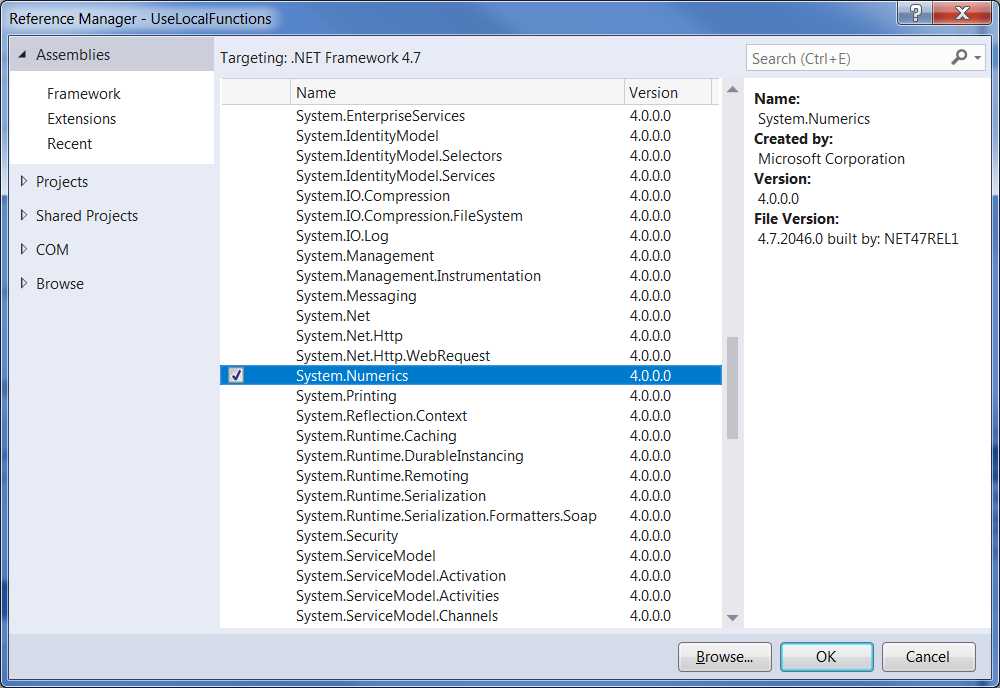标签:mod number strong sync ogr 程序集 oca color eof
VS 2017 的 C# 7.0 中引入了本地方法,本地方法是一种语法糖,允许我们在方法内定义本地方法。更加类似于函数式语言,但是,本质上还是基于面向对象实现的。
先看一个示例:
1 using static System.Console; 2 3 namespace UseLocalFunctions 4 { 5 class Program 6 { 7 static void Main(string[] args) 8 { 9 void Add(int x, int y) 10 { 11 WriteLine($"Sum of {x} and {y}: is {x + y}"); 12 } 13 14 void Multiply(int x, int y) 15 { 16 WriteLine($"Multiply of {x} and {y} is: {x * y}"); 17 Add(30, 10); 18 } 19 20 Add(10, 30); 21 Multiply(40, 30); 22 23 ReadLine(); 24 } 25 } 26 }
在此示例中,在 Main 方法内,嵌套定义了两个方法:Add 和 Multiply。这个方法可以在 Main 方法内被使用。这种方法被称为本地方法。英文称为:Local function.
使用 ILDasm 工具,可以看到编译之后的结果。

这两个本地方法被翻译成了两个静态的私有方法,它只能在定义的方法内被调用。
本地方法的语法定义为:
<modifiers: async | unsafe> <return-type> <method-name> <parameter-list>
方法的修饰符只有两种:async 和 unsafe,所有的本地方法都是私有的
本地方法也可以带有返回类型。如果类型用错的话,Visual Studio 可以给出提示。
1 class Program 2 { 3 static void Main(string[] args) 4 { 5 PrintStudentMarks(101, 6 new Subject 7 { 8 SubjectName = "Math", 9 Marks = 96 10 }, new Subject 11 { 12 SubjectName = "physics", 13 Marks = 88 14 }, new Subject 15 { 16 SubjectName = "Chem", 17 Marks = 91 18 }); 19 20 ReadLine(); 21 } 22 23 public static void PrintStudentMarks(int studentId, params Subject[] subjects) 24 { 25 WriteLine($"Student Id{studentId} Total Marks: {CalculateMarks()}"); 26 WriteLine($"Student wise marks"); 27 foreach(var subject in subjects) 28 { 29 WriteLine($"Subject Name: {subject.SubjectName}\t Marks: {subject.Marks}"); 30 } 31 32 decimal CalculateMarks() 33 { 34 decimal totalMarks = 0; 35 foreach(var subject in subjects) 36 { 37 totalMarks += subject.Marks; 38 } 39 40 return totalMarks; 41 } 42 } 43 44 public class Subject 45 { 46 public string SubjectName 47 { 48 get; set; 49 } 50 51 public decimal Marks 52 { 53 get; set; 54 } 55 } 56 }
本地方法不需要维护调用堆栈,而递归方法需要维护调用堆栈,本地方法效率更高。下面的示例演示了两种方法的区别。
注意:该示例使用了类型 BigInteger ,需要添加对程序集 System.Numeric.dll 的引用。

代码如下。
1 class Program 2 { 3 static void Main(string[] args) 4 { 5 Stopwatch watch = new Stopwatch(); 6 watch.Start(); 7 BigInteger f1 = GetFactorialUsingLocal(9000); 8 watch.Stop(); 9 WriteLine($"Using local function: {watch.ElapsedTicks}"); 10 11 watch.Reset(); 12 watch.Start(); 13 BigInteger f2 = GetFactorial(9000); 14 watch.Stop(); 15 WriteLine($"Using recursive function: {watch.ElapsedTicks}"); 16 } 17 18 private static BigInteger GetFactorialUsingLocal(int number) 19 { 20 if (number < 0) 21 throw new ArgumentException("negative number", nameof(number)); 22 else if (number == 0) 23 return 1; 24 BigInteger result = number; 25 while (number > 1) 26 { 27 Multiply(number - 1); 28 number--; 29 } 30 31 void Multiply(int x) => result *= x; 32 return result; 33 } 34 35 private static BigInteger GetFactorial(int number) 36 { 37 if (number < 0) 38 throw new ArgumentException("nagative number", nameof(number)); 39 return number == 0 ? 1 : number * GetFactorial(number - 1); 40 } 41 }
在我的机器上,结果如下:
Using local function: 181770
Using recursive function: 456602
可以看到两者之间的性能差异。
此时,为了传递 result ,在生成的代码中,编译器会自动做一些额外的工作。

当创建 Lambda 的时候,将会创建一个委托,这需要内存分配,因为委托是一个对象。而本地方法则不需要,它是一个真正的方法。
另外,本地方法可以更为有效地使用本地变量,Lambda 将变量放到类中,而本地方法可以使用结构,而不使用内存分配。
这意味着调用本地方法更为节约且可能内联。
Lambda 也可以实现递归,但是代码丑陋,您需要先赋予 lambda 为 null。本地方法可以更为自然地递归。
Lambda 不能使用泛型。这是因为需要赋予一个实例类型的变量。
Lambda 不能使用 yield return (以及 yield break)关键字,以实现 IEnumerable<T> 返回函数。本地方法可以。
标签:mod number strong sync ogr 程序集 oca color eof
原文地址:http://www.cnblogs.com/haogj/p/7636915.html